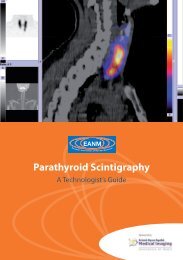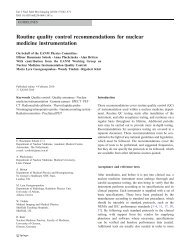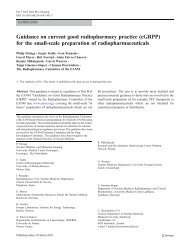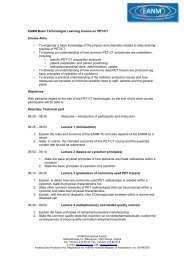Parathyroid Scintigraphy - European Association of Nuclear Medicine
Parathyroid Scintigraphy - European Association of Nuclear Medicine
Parathyroid Scintigraphy - European Association of Nuclear Medicine
You also want an ePaper? Increase the reach of your titles
YUMPU automatically turns print PDFs into web optimized ePapers that Google loves.
angles round the patient) create multiple raw<br />
data sets containing the representation <strong>of</strong> the<br />
data in one projection. Each <strong>of</strong> these is stored<br />
in the computer in order to process them later<br />
on and extract the information.<br />
Matrix<br />
Each projection is collected into a matrix.<br />
These are characterised by the number <strong>of</strong><br />
picture elements or pixels. Pixels are square<br />
and organised typically in arrays <strong>of</strong> 64×64,<br />
128×128 or 256×256.<br />
In fact, the choice <strong>of</strong> matrix is dependent on<br />
two factors:<br />
a) The resolution: The choice should not degrade<br />
the intrinsic resolution <strong>of</strong> the object. The<br />
commonly accepted rule for SPECT (Groch<br />
and Erwin 2000) is that the pixel size should be<br />
one-third <strong>of</strong> the full-width at half-maximum<br />
(FWHM) resolution <strong>of</strong> the organ, which will<br />
depend on its distance from the camera face.<br />
The spatial resolution <strong>of</strong> a SPECT system is <strong>of</strong><br />
the order <strong>of</strong> 18–25 mm at the centre <strong>of</strong> rotation<br />
(De Puey et al. 2001). Thus a pixel size <strong>of</strong><br />
6-8 mm is sufficient, which, for a typical large<br />
field <strong>of</strong> view camera, leads to a matrix size <strong>of</strong><br />
64×64.<br />
b) The noise: This is caused by the statistical<br />
fluctuations <strong>of</strong> radiation decay. The lower the<br />
total counts, the more noise is present and, if<br />
the matrix size is doubled (128 instead <strong>of</strong> 64),<br />
the number <strong>of</strong> counts per pixel is reduced by<br />
0<br />
a factor <strong>of</strong> 4. 128×128 matrices produce approximately<br />
three times more noise on the<br />
image after reconstruction than do 64 x 64<br />
matrices (Garcia et al. 1990).<br />
The planar images (or static projections) do<br />
not have the reconstruction problem and can<br />
be acquired over longer times so a 256× 256<br />
matrix is commonly used.<br />
Zoom factor<br />
The pixel size is dependent on the camera<br />
field <strong>of</strong> view (FOV). When a zoom factor <strong>of</strong><br />
1.0 is used, the pixel size (mm) is the useful<br />
FOV (UFOV, mm) divided by the number <strong>of</strong><br />
pixels in one line. When a zoom factor is used,<br />
the number <strong>of</strong> pixels per line should first be<br />
multiplied by this factor before dividing it into<br />
the FOV.<br />
Example:<br />
Acquisition with matrix 128, zoom 1.0 and<br />
UFOV 400 mm. Pixel size: 400/128=3.125 mm.<br />
The same acquisition with a zoom factor <strong>of</strong> 1.5.<br />
Pixel size: 400/(1.5×128)=2.08 mm.<br />
It is important to check this parameter before<br />
the acquisition, as it is very <strong>of</strong>ten used in<br />
parathyroid imaging, especially if a subtraction<br />
technique is used.<br />
Preferred orbit<br />
Either circular or elliptical orbits can be used<br />
in SPECT imaging (Fig. 1). A circular orbit (Fig.

















